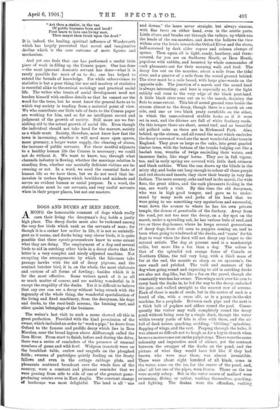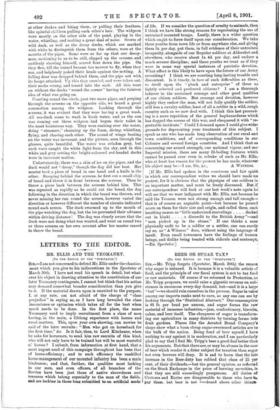DOGS AND DUCKS AT IKEN DECOY.
A"N°the honourable remnant of dogs which really earn their living the decoyman's dog holds a justly high place. The decoy ducks must also be reckoned among the very few birds which rank as the servants of man; for though it is a rather low metier in life, it is not so unintelli- gent as it seems, and ducks being very clever birds, it is quite possible that these agentsprovocate-urs know to some extent what they are doing. The employment of a dog and several birds to aid in catching other birds in a decoy shows that the latter is a very complex and nicely adjusted machine. Not excepting the arrangements by which the falconers take passage hawks with the aid of decoy pigeons, and the sentinel butcher bird, it is, on the whole, the most elaborate and curious of all forms of fowling ; besides which it is far the most effective. Some writers speak of it as all so much matter of course, and see nothing wonderful in it except the stupidity of the ducks. Yet it is difficult to believe that any one can see a decoy without being struck with the ingenuity of the whole thing, the wonderful specialisation of the living and fixed machinery, from the decoyman, his dogs and ducks, to the reed-built screens, the burning turf, and other quaint belongings of the business.
The writer's last visit to such a scene showed all this in great perfection. Provided with the kind permission of the owner, which included an order to " work a pipe," be drove from Orford to the famous and prolific decoy which lies in Iken Marshes, near the broad lagoon above Aldborough called the Iken River. From start to finish, before and during the drive, there was a series of reminders of the presence of unusual numbers of game and wild-fowl. Widgeon (roasted) were on the breakfast table, curlew and seagulls on the ploughed fields; swarms of partridges quietly feeding on the frosty follows and. even in the cottage cabbage plots, and pheasants scattered broadcast over the whole face of the country, were a constant and pleasant reminder that we were passing from side to side of one of the greatest game- producing estates even in East Anglia. The constant change of landscape was most delightful. The land is all "ups and downs.," the lanes never straight, but always sinuous, with fine trees on either hand, even in the arable parts. Little rivers and brooks cut through the valleys, up which ran the heads of the sea-marshes, and down the hollows the view widens over the levels towards the Orford River and the shore. half-screened by dark alder copses and solemn clumps of spruce. Then again all is light, sandy, heathery, and furze- covered, for you are on Sudborne Reath, or Iken Reath, populous with rabbits, and haunted by whole commandos of cock pheasants out for their morning walk and feed. The decoy lies out on the marshes, about a mile from the tidal river, and a quarter of a mile from the sound ground behind. The river must be a mile broad, with large pine-woods on the opposite side. The junction of a marsh and the sound land is always interesting; and here is especially so, for the light rabbity soil runs to the very edge of the black peat-land. A little black river runs out on to the marsh, draining the flats to some extent. This bit of sound ground runs beside the stream almost to the decoy, though there is a marsh on one side, and one or two black peaty cornfields on the other, in which the cane-coloured stubble looks as if it were set in soot, and the ditches are full of white feathery reeds. On this tongue there are short, sound turf, and as beautiful old pollard oaks as there are in Richmond Park. Also, behind, up the stream, and all round the moat which encircles the decoy's screen of wood are the most wonderful alder trees in England. They grow as large as the oaks, into great gnarled timber trees, with the bottom of the trunks bulging out like a baobab tree, wreaths of twigs encircling their waists, and immense limbs, like stags' horns. They are in full vigour, too, and in early spring are covered with little dark crimson and black catkins. When the sun draws up the blinds in the misty sky, and looks out long enough to colour all these purple and red shoots and tassels, they show their beauty in very fine fashion. The mere scenery, oaks and turf in the marsh, the wide flats, the great alders, and the cock pheasants feeding in the sun, are worth a visit. By this time the old decoyman, who was in high good temper, and gave us to under- stand by many nods and jerks of his head that we were going to see something very mysterious and successful, went down the avenue to where he has his own private temple, the damns et penetralia of the duckery. Away from the road, yet not too near the decoy, on a dry spot on the marsh, under a spreading oak, he has various huts of reed, and two or three dog-houses, where he keeps several generations of decoy dogs, horn old ones to puppies coming on, turf to burn when going to windward of the ducks, and "coats' for his dogs to wear when the duck will not decoy any longer to the natural article. The dog at present used is a nondescript collie, but more like a fox than a dog. The colour is that of the splendid red orange foxes of Canada or Northern China, the tail very long, with a thick mass of fur at the end, the muzzle as sharp as an opossum's, the ears small and pricked. The walk and manners of the dog when going round and expecting to aid in catching ducks are also not dog-like, but like a fox on the prowl, though she constantly watches her owner. Throwing a sack over his arm to carry back the ducks in, he led the way to the decoy, unlocked the gate, and walked straight to the nearest row of screens. Each of these is made of reeds, but in the centre of each is a board of elm, with a cross slit, as in a penny-in-the-slot machine, for a peephole. Between each pipe and the next is a thick belt of poplars and alders round the pool. Conse- quently the visitor may walk completely round the decoy pond without being seen by a single duck, though the water within twenty yards of him is alive with them, and the air full of duck noises, quacking, scolding, " bibbling," splashing, flapping of wings, and the rest. Peeping through the holes, it was almost as difficult not to laugh as for a boy in church when he sees a mouse come out onthe pulpit steps. There were the same solemnity and imperative need of silence, yet the contrast between the swagger of the ducks on the pond, and the picture of what they would have felt like if they had known who were near them, was almost irresistible. There were about eight hundred of all kinds, some in the water, some on the ice, for the centre of the pond, and, alas ! all but one of the pipes, were frozen. Those on the ice were mostly asleep. But in the water scores of mallard were swimming, diving, or rather, washing themselves, quacking, and fighting. The drakes were the offenders, rushing
at other drakes and biting them, or pulling their feathers, like spiteful children pulling each other's hair. The widgeon were. mostly on the other side of the pond, playing in the water, whistling, and making a great deal of noise. Scores of wild duck, as well as• the decoy ducks, which are marked with white to distinguish them from the others, were at the mouths of the pipes. Some were so far up that our decoy- man, motioning to us to be still, slipped up the screens, and suddenly showing himself, scared four down the pipe. On they flew, till the tunnel became too narrow to fly, when they ran, and helplessly poked their heads against the netting. A falling door was dropped behind them, and the pipe net with its hoops attached. Up this they crawled, and were taken out," their necks wrung, and tossed into the sack. All this went on without the ducks "round the corner" having the faintest idea of what was going on.
Coasting round the circle, past two more pipes, and peeping through the screens on the opposite side, we heard a great commotion among the widgeon. Looking through the screens, it was evident that they were having a great wash. All sea-duck come to wash in fresh water, and as the sun was coming out these widgeon had begun their toilet in the most boisterous way. They were rushing over the water, doing "steamers," churning up the foam, diving, whistling, flying, and chasing each other. The sound of wings beating on the water was incessant, and the picture, seen through the glasses, quite beautiful. The water was celadon grey, but each wave caught the white light from the sky, and in this white and grey setting the bright-coloured red-headed ducks were in incessant motion.
Unfortunately, there was a skin of ice on the pipes, and the duck would not "decoy," though the dog did her best. Her master took a piece of bread in one hand and a knife in the other. Stooping behind the screens, he first cut a small chip of bread and threw it in front between the screens. Then he threw a piece back between the screens behind him. This was repeated as rapidly as he could cut the bread, the dog following in the direction in which the bread was thrown, and never missing her run round the screen, however varied the direction or however different the number of circuits indicated round each screen. The duck swarmed up to the mouth of the pipe watching the dog, but the ice prevented their advance within driving distance! The dog was clearly aware that the duck were not doing what was wanted, and went on round two or three screens on her own account after her master ceased to threw the bread.







































 Previous page
Previous page